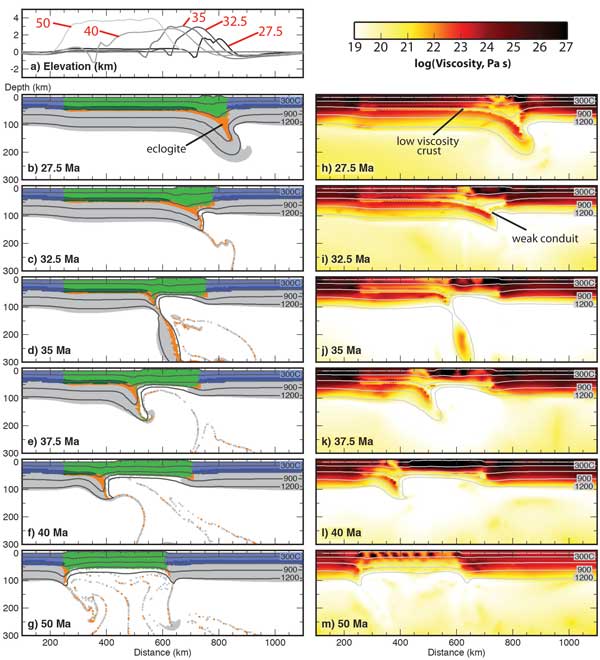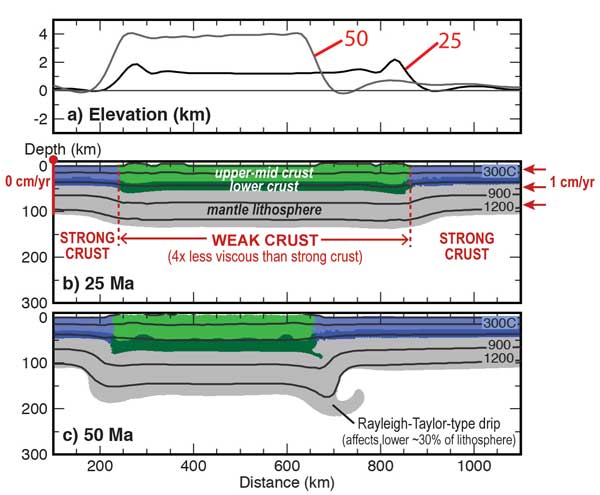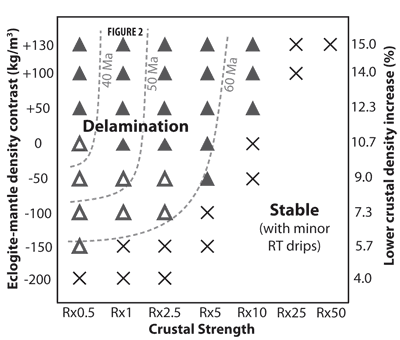 |
Crustal eclogitization and lithosphere delamination in orogens |
Neil J. Krystopowicz1,2 and Claire A. Currie3
1Departent of Earth and Atmospheric Sciences, University of Alberta, Edmonton, AB Canada
2Department of Earth Sciences, University of Toronto, Toronto, ON, Canada, neil.krystopowicz@mail.utoronto.ca
3Department of Physics, University of Alberta, Edmonton, AB, Canada, claire.currie@ualberta.ca
This webpage is a summary of: Krystopowicz, Neil J., Claire A. Currie, Crustal eclogitization and lithosphere delamination in orogens, Earth Planet. Sci. Lett., 361, 195-207, 2013.
During orogenesis, shortening produces thick continental crust and high elevations. In many orogens, geophysical and geological observations indicate that the lower crust and mantle lithosphere have been thinned or are absent. As the crust thickens through shortening, the lower crust may be depressed into the eclogite stability field and undergo metamorphic eclogitization, a phase transition which can be accompanied by significant densification (Bousquet et al., 1997). We investigate the role of crustal eclogitization in triggering lithosphere removal through delamination.
Two-dimensional numerical models are used to simulate crustal thickening and synorogenic eclogitization of lower crust. The coupled thermal-mechanical evolution of the lithosphere-upper mantle system is modeled using the SOPALE code, using model parameters based on earlier studies (e.g., Beaumont et al., 2006). The models consist of 100 km thick continental lithosphere with an ~850 km wide region of weak crust, surrounded by strong crust (Figure 1). This replicates the orogenic vise model, in which shortening occurs within a zone of inherited weakness (Ellis et al., 1998). Shortening is induced by introducing lithosphere through the right-hand boundary at 1 cm/yr, wherein the model evolves dynamically in response to boundary conditions and internal buoyancy forces.

Figure 1: Evolution of a model with no lower crustal eclogitization. (a) surface topography (red numbers give the model time in Ma), and model geometry at (b) 25 Ma and (c) 50 Ma after initiation of shortening. Red labels in (b) indicate the model materials and velocity boundary conditions. Click here or on figure for enlargement.
Figure 2 shows a model in which there is no crustal eclogitization. Over 50 Ma, the weak crustal region undergoes symmetric pure shear shortening, producing thickened lithosphere and surface uplift. Thickening is confined to the area with weak crust. The thickened lithosphere remains relatively stable with only minor Rayleigh-Taylor-type instabilities that remove the lowermost lithosphere, but thick lithosphere persists beneath the orogen.

Figure 2: Model with lower crustal eclogitization. All other parameters are identical to those in the previous model. Eclogitized crust is 130 kg/m3 denser than mantle. (a) Surface topography, (b-g) model geometry, (h-m) viscosity structure at the given model times.
Lower crustal eclogitization significantly affects model evolution. With shortening, thickened lower crust enters the eclogite stability field (Hacker et al., 2003). In the model in Figure 1, the lower crustal density is increased to 130 kg/m3 greater than mantle, corresponding to ~90% eclogitization of mafic crust. The negative buoyancy of eclogitized crust results in localized shortening at the orogen edges, with stronger localization on the right due to the incoming strong block. This produces crustal thickening and surface uplift above the eclogite root and underthrusting of orogen mantle lithosphere beneath the strong block. The underthrust lithosphere becomes gravitationally unstable and peels away from the crust. In our models, the weak crust forms a low-viscosity layer, which promotes decoupling in the crust (Figure 1h-m). Through delamination, mantle lithosphere and eclogitized lower crust are fully removed below the orogen.
A series of model tests examine the effect of variations in crustal strength and eclogite density (Figure 3). Crustal strength was varied by linearly scaling the crustal viscosity relative to the above reference model (R). For the weakest crust, delamination occurs if eclogite is up to 150 kg/m3 less dense than mantle. The minimum density for delamination increases with increasing crustal strength, owing to the inability of mantle lithosphere to decouple from stronger crust. Models with strong crust and low density eclogite do not exhibit delamination. Additional tests show that variations in mantle lithosphere strength may change the style of delamination, but do not strongly affect the propensity for delamination.

Figure 3: Model behaviour for variations in crustal strength and density contrast between eclogitized crust and mantle. Crustal strength variations are reported as a linear scaling of the viscous strength of the reference model (R; Figure 2). Crosses are models that remain stable and triangles are models which exhibit delamination. Dashed lines show the time (since initiation of shortening) for removal of >90% of orogen mantle lithosphere.
Our models confirm that delamination requires a weak layer that decouples the mantle lithosphere and crust (e.g., Meissner & Mooney, 1998). In addition, delamination is triggered by the formation of a conduit connecting the weak layer to sublithospheric mantle (e.g., Bird, 1979; Morency & Doin, 2004). Previous studies have demonstrated the onset of delamination through localized convective thinning or retreat/detachment of a dense subducting plate (Morency & Doin, 2004; Beaumont et al., 2006; Faccenda et al., 2009; Gray & Pysklywec, 2012; Ueda et al., 2012). Our models show that gravitational instability of eclogitized lower crust can also induce delamination.
Although these models are simplified relative to natural orogens, they provide insight into orogen dynamics and demonstrate the potential role of eclogitization in lithosphere removal. Even a modest density increase for eclogitized crust produces localized shortening, enhancing development of a thick root of eclogitized crust and mantle lithosphere. This can lead to synorogenic delamination in regions where eclogitized crust is weak and is slightly (7-8%) denser than granulitic crust (Figure 3). This likely requires hydrous fluids in the deep crust, as water promotes eclogitization and significantly reduces rock strength (e.g., Jackson et al., 2004).
The models also demonstrate how delamination may be recognized in surface observations. Delamination results in complete removal of orogenic mantle lithosphere, which is consistent with inferred thin lithosphere for some orogens based on seismic, gravity, and elevation data (e.g., Beck & Zandt, 2002; Sengor et al., 2003; Jimenez-Munt et al., 2008). Delamination produces contemporaneous migration of crustal deformation and surface uplift (Figure 1). Upwelling mantle and rapid crustal heating may lead to magmatism that migrates across the orogen. This style of delamination may explain patterns of crustal deformation and volcanism of the Central Andes and East Anatolian Plateau (Beck & Zandt, 2002; Gogus & Pysklywec, 2008).
References
-
Beaumont, C., Nguyen, M.H., Jamieson, R.A., Ellis, S., 2006. Crustal flow modes in large hot orogens. In: Law, R.D., Searle, M.P., Godin, L. (Eds.), Channel Flow, Ductile Extrusion, and Exhumation of Lower-Mid Crust in Continental Collision Zones, 268. Special Publications, Geological Society London, pp. 91–145.
-
Beck, S.L., Zandt, G., 2002. The nature of orogenic crust in the central Andes. J. Geophys. Res., 107, http://dx.doi.org/10.1029/2000JB000124.
-
Bird, P., 1979. Continental delamination and the Colorado Plateau. J. Geophys. Res., 84, 7561–7571.
-
Bousquet, R., Goffe, B., Henry, P., Le Pichon, X., Chopin, C., 1997. Kinematic, thermal and petrological model of the Central Alps: Lepontine metamorphism in the upper crust and eclogitisation of the lower crust. Tectonophysics, 273, 105–127.
-
Ellis, S., Beaumont, C., Jamieson, R.A., Quinlan, G., 1998. Continental collision including a weak zone: the vise model and its application to the Newfound- land Appalachians. Can. J. Earth Sci., 35, 1323–1346.
-
Faccenda, M., Minelli, G., Gerya, T.V., 2009. Coupled and decoupled regimes of continental collision: numerical modeling. Earth Planet. Sci. Lett., 278, 337–349.
-
Gogus, O.H., Pysklywec, R.N., 2008b. Mantle lithosphere delamination driving plateau uplift and synconvergent extension in eastern Anatolia. Geology, 36, 723–726.
-
Gray, R., Pysklywec, R.N., 2012. Geodynamic models of mature continental collision: evolution of an orogen from lithospheric subduction to continental retreat/delamination. J. Geophys. Res., 117, B03408, http://dx.doi.org/10.1029/ 2011JB008692.
-
Hacker, B.R., Abers, G.A.,Peacock,S.M.,2003.Subductionfactory1.Theoretical mineralogy, densities,seismicwavespeeds,andH2O contents. J. Geophys. Res., 108, B12029,http://dx.doi.org/10.1029/2001JB001127.
-
Jackson, J.A., Austrheim, H., McKenzie, D., Priestley, K., 2004. Metastability, mechanical strength, and the support of mountain belts. Geology, 32, 625–628
-
Jimenez-Munt, I., Fernandez, M., Verges, J.,Platt,J.P.,2008. Lithosphere structure underneath the Tibetan Plateau inferred from elevation, gravity and geoid anomalies. Earth Planet. Sci. Lett., 267, 276–289.
-
Meissner, R.O., Mooney, W.D., 1998. Weakness of the lower continental crust; a condition for delamination, uplift, and escape. Tectonophysics, 296, 47–60.
-
Morency, C., Doin, M.-P., 2004. Numerical simulations of the mantle lithosphere delamination. J. Geophys. Res., 109, B03410, http://dx.doi.org/10.1029/ 2003JB002414.
-
Sengor, A.M.C., Ozeren, S., Genc, T., Zor, E., 2003. East Anatolian high plateau as a mantle-supported, north–south shortened domal structure. Geophys. Res. Lett., 30, 8045, http://dx.doi.org/10.1029/2003GL017858.
-
Ueda, K., Gerya, T.V., Burg, J.-P., 2012. Delamination in collisional orogens: thermomechanical modeling. J. Geophys. Res., 117, B08202, http://dx.doi.org/ 10.1029/ 2012JB009144.
last updated 14th March, 2013 |
